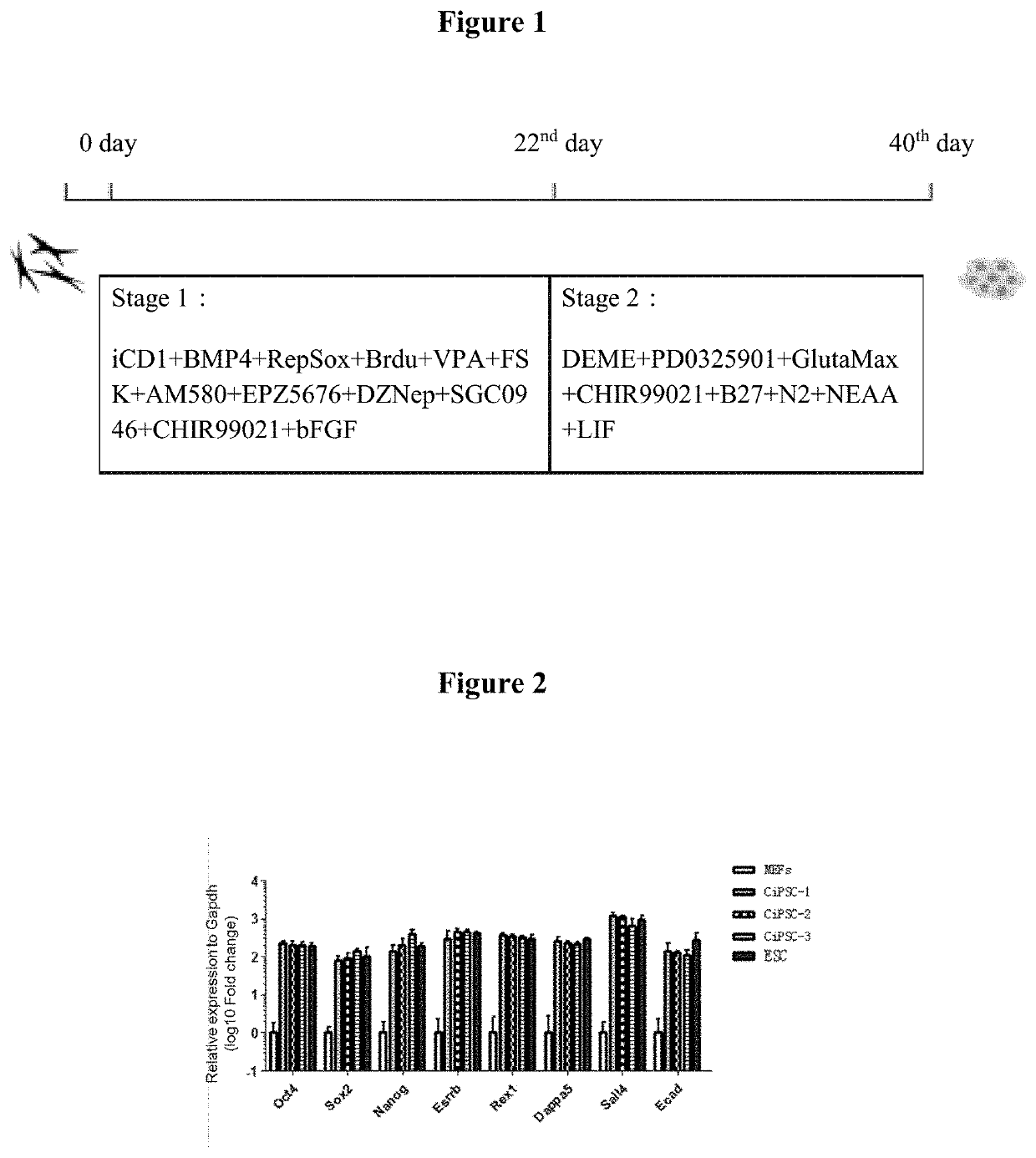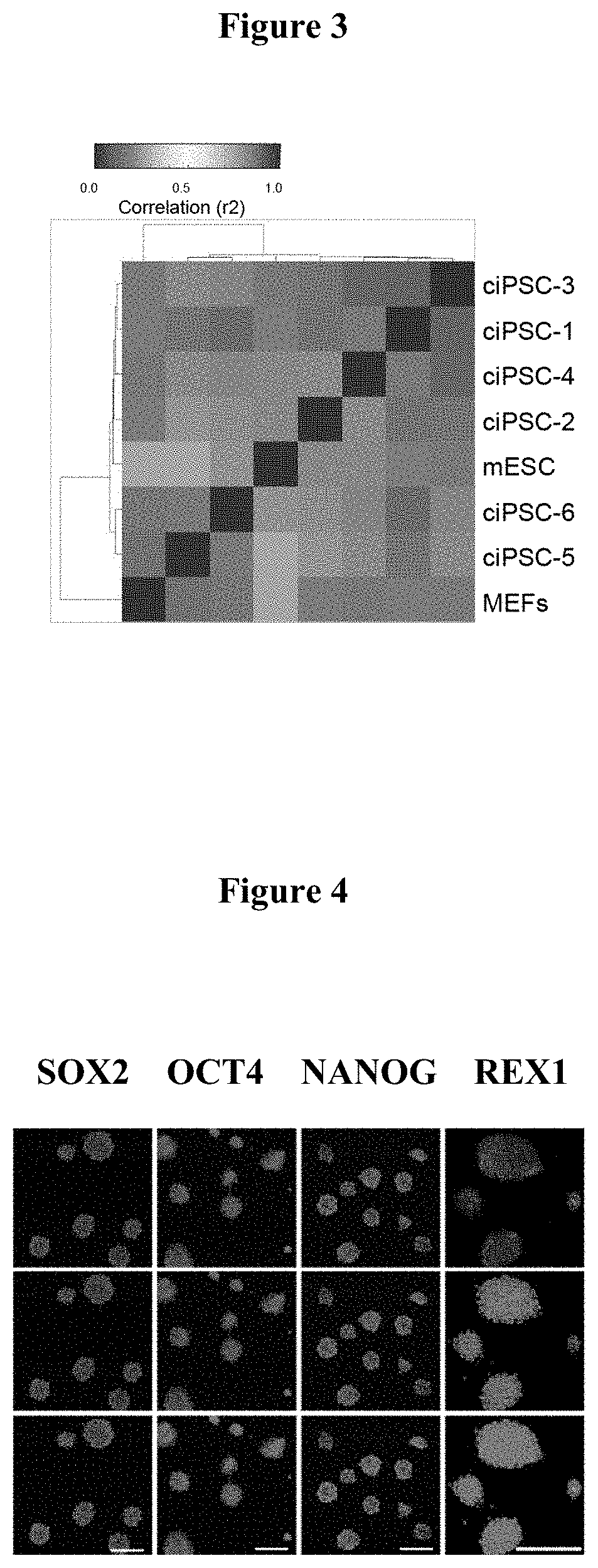Culture system for chemically inducing generation of pluripotent stem cells and chemical reprogramming method using same
- Summary
- Abstract
- Description
- Claims
- Application Information
AI Technical Summary
Benefits of technology
Problems solved by technology
Method used
Image
Examples
example 1
n of Pluripotent Stem Cells in the Culture System for Chemical Induction of Pluripotent Stem Cells
[0144]The culture medium for use in Example 1 comprises iCD1 medium as a basic medium and 10 ng / ml BMP4, 10 μM Brdu, 5 μM RepSox, 10 μM Forsklin, 0.1 mM VPA, 0.05 μM AM580, 5 μM EPZ5676, 0.05 μM DZNep, 5 μM SGC0946, 50 μg / ml vitamin C, 3 μM CHIR99021 and 10 ng / ml basic fibroblast growth factor. Mouse embryo fibroblasts, mouse neonatal fibroblasts, mouse lung fibroblasts, mouse tail tip fibroblasts, mouse neural stem cells were seeded in the medium for chemical induction of pluripotent stem cells at a density of 20,000 cells per well (12 wells) or 50,000 cells per well (6 wells) and the mouse hepatocytes were seeded in the same medium for chemical induction of pluripotent stem cells at a density of 500,000 cells per well (6-well plate). The medium was freshed on daily basis. After culturing for 22 days, the above medium for chemical induction of pluripotent stem cells was changed to DMEM...
example 2
ization of the Chemically Induced Pluripotent Stem Cells (ciPSCs)
[0145]Expression levels of endogenous pluripotent genes Oct4, Nanog, Sox2, Esrb, Rex1Dappa5, Sall4 and Cdh1 in ciPSCs were measured by quantitative RT-PCR. As shown in FIG. 2, the expression levels of these endogenous pluripotent genes were the same as those measured in the mouse embryo stem cells.
[0146]Transcriptomic profiles of ciPSCs were obtained via RNA-seq. As shown in FIG. 3, the transcriptomic profiles of ciPSCs were the same as that of the mouse embryo stem cells.
[0147]Further, as shown in FIG. 4, the protein expression levels of endogenous pluripotent genes Oct4, Nanog, Sox2, Esrb, Rex1Dappa5, Sall4 and Cdh1 in ciPSCs were confirmed by immunofluorescence.
example 3
iation Profile of Chemically Induced Pluripotent Stem Cells in Mouse
[0148]ciPSCs obtained according to example 1 were injected to NOD-SCID mouse. As shown in FIG. 5, ciPSCs formed teratoma and were differentiated into three germ layers (cartilage: mesoderm, muscle: mesoderm, nerve: ectoderm; gut-like epithelium: entoderm) in mouse. As shown in FIG. 6, ciPSCs were maintained with normal karyotype during passage. ciPSCs were injected into mouse blastocyst and then progeny chimeric mouse was obtained, as shown in FIG. 7.
[0149]As demonstrated in the results of Examples 2 and 3, the chemically induced pluripotent stem cells obtained by culturing in the culture system as described herein have complete pluripotency. By using the culture system as described herein, somatic cells can be effectively reprogrammed into pluripotent stem cells through two-stage culturing process without any serum. And there is no need to replate cells during culture, such that the culturing process is simplified....
PUM
 Login to View More
Login to View More Abstract
Description
Claims
Application Information
 Login to View More
Login to View More - R&D
- Intellectual Property
- Life Sciences
- Materials
- Tech Scout
- Unparalleled Data Quality
- Higher Quality Content
- 60% Fewer Hallucinations
Browse by: Latest US Patents, China's latest patents, Technical Efficacy Thesaurus, Application Domain, Technology Topic, Popular Technical Reports.
© 2025 PatSnap. All rights reserved.Legal|Privacy policy|Modern Slavery Act Transparency Statement|Sitemap|About US| Contact US: help@patsnap.com



